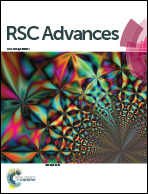Remarkable colorimetric sensing behavior of pyrazole-based chemosensor towards Cu(ii) ion detection: synthesis, characterization and theoretical investigations†
Abstract
We report the synthesis of a new imine based ligand, 3-((3-methoxybenzylidene)amino)-1H-pyrazol-5-ol (HL) and its Cu(II) complexes in 2 : 1 (HL : metal) and 1 : 1 : 1 (HL : metal : HQ) stoichiometric ratio using 8-hydroxyquinoline (HQ) as an additional bidentate ligand. The synthesized ligand (HL) and its Cu(II) complexes (1 and 2) are structurally characterized using FT-IR, electronic absorption and emission, NMR and MS techniques. Furthermore, the complexation of Cu2+ with HL leads to the immediate formation of brown colour solution which indicates that HL can act as simple colorimetric sensor for Cu2+ ions. We further investigated that the sensor could selectively bind to the Cu2+ ions even in the presence of competitive ions such as Mn2+, Fe2+, Co2+, Ni2+, Zn2+, Ag+ and Na+ ions in aqueous solutions which was studied by electronic absorption spectroscopy. The HL ligand has been investigated for its reactive properties by density functional theory (DFT) calculations. Quantum molecular descriptors describing local reactive properties have been calculated in order to identify the most reactive molecule sites of title compounds. DFT calculations encompassed molecular electrostatic potential (MEP), local average ionization energies (ALIE), Fukui functions and bond dissociation energies for hydrogen abstraction (H-BDE).



 Please wait while we load your content...
Please wait while we load your content...